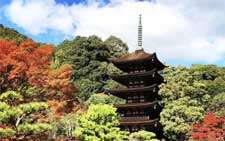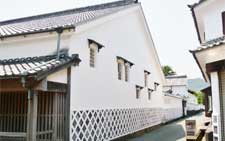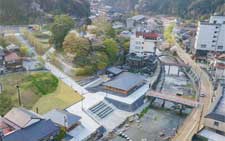Culture & Tourism

Motonosumi Shrine
Motonosumi Shrine is dedicated to the deity of prosperous business, abundant fish harvest, maritime safety, good relationships, the prosperity of descendants, clear vision, harmony and virtue, traffic safety, and academic achievement. The sight of 123 red torii gates, which were donated over a period of 10 years starting in 1987, stretching over 100 meters from the Shiofuki ( a hole in a coastal rock where seawater gushes up) at the edge of the Dragon Palace is truly impressive. It has gained international attention, after being featured in “Japan's 31 Most Beautiful Places” selected by an American TV network.

Tsunoshima
Tsunoshima is said to be named after its resemblance to the horns of a cow, as it has two distinct capes. Its name can be found in ancient wooden tablets excavated from the Heijo Palace site and in the “Manyoshu” anthology*, indicating its long history. In 1997, the entire area of the island was incorporated into the Kitakanagato Coastal National Park, attracting many tourists for activities such as swimming, camping, and leisure fishing. The Sunoshima Lighthouse, a stone lighthouse located in Lighthouse Park, draws numerous visitors every year. In addition, the Tsunoshima Bridge, which opened in 2000 and spans 1,780 meters, is a famous filming location for commercials and movies.
*Manyoshu: an anthology of Japanese poetry compiled during the 7th and 8th centuries

Ruriko-ji Five-Storied Pagoda
The Ruriko-ji Five-Stories Pagoda is the 10th oldest five-storied pagoda in Japan and is regarded as one of the three most famous pagodas in the country. It is highly acclaimed as one of the finest architectural structures from the mid-Muromachi period. Designated as a national treasure of Japan, the pagoda serves as a symbol of Yamaguchi, elegantly conveying Ouchi culture agaisnt a backdrop of cherry blossoms and maple leaves. Furthermore, it is illuminated from sunset until 22:00, providing a captivating night-time view.

Hagi Castle Town
Hagi Castle Town, a city centered around the castle, retains a city townscape and flourishing city surrounding the castle walls. It features the grand samurai residence of the noble Mori clan with thick white walls, earthen walls that showcase summer tangerines, and a landscape where the high earthen walls intersect at right angles. The town is abundant with attractions that allow visitors to trace the footsteps of prominent figures who represented the turbulent periods of modern and contemporary Japan. The neighborhood is divided into a grid pattern, and it is adorned with traditional houses, cafes, general stores, and historical sites. It is a deligtful town where visitors can explore and enjoy a stroll.

Kintaikyo Bridge
Kintaikyo Bridge is a series of five connected bridges located on the Nishiki River in Iwakuni City, Yamaguchi Prefecture. It is considered one of Japan's three most famous bridges and has been designated as a national scenic spot (including the upstream and downstream areas) due to its picturesque natural surroundings. Built in 1673 with the wish for a bridge that would not be washed away, it showcases the culmination of wisdom and craftsmanship. Its intricate and unique structure spans approximately 200 meters across the river and boasts a beautiful appearance. Over the course of more than 350 years since its construction, the technical excellence and beauty of Kintaikyo Bridge have been preserved and admired.

Yuda and Nagato Yumoto Onsen
Yuda Onsen is located close to Yamaguchi City center and offers a charming hot spring area with excellent natural scenery. With a daily flow of 2,000 tons of natural hot spring water, the alkaline hot springs are known for their cleansing effects and referred to as “beauty baths” beloved by many since ancient times. Nagato Yumoto Onsen is one of the oldest hot springs in Yamaguchi Prefecture, with a rich history. In 2020, cafes and bars were opened by remodelling vacant houses in the hot spring town.
For further information, please refer to https://yamaguchi-tourism.jp
Information may be found in Japanese, Korean, and Chinese.